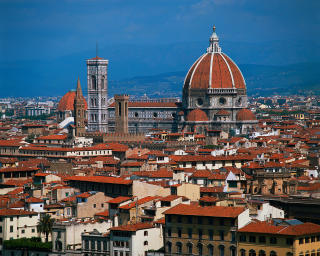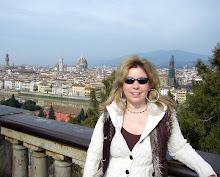

 On Wednesday evening I decided to go to Cortona the following day. When I woke up on Thursday, it was pouring down rain, but I wasn’t about to let that stop me, so I made my way to the train station. Despite my transportation woes, described earlier, I finally made it to Cortona. The rain was still coming down when I arrived, but that did nothing to take away from the magic of this small Tuscan hilltown. From the moment I stepped off the bus, I could see why Frances Mayes was so enchanted with this tiny village when she first saw it. I’ve heard that ever since she wrote Under the Tuscan Sun, Cortona has been overrun with tourists. Thankfully, on this cold, wet February morning, there were few to be found, and I and the locals seemed to have the place to ourselves.
On Wednesday evening I decided to go to Cortona the following day. When I woke up on Thursday, it was pouring down rain, but I wasn’t about to let that stop me, so I made my way to the train station. Despite my transportation woes, described earlier, I finally made it to Cortona. The rain was still coming down when I arrived, but that did nothing to take away from the magic of this small Tuscan hilltown. From the moment I stepped off the bus, I could see why Frances Mayes was so enchanted with this tiny village when she first saw it. I’ve heard that ever since she wrote Under the Tuscan Sun, Cortona has been overrun with tourists. Thankfully, on this cold, wet February morning, there were few to be found, and I and the locals seemed to have the place to ourselves.

 And what a place it is! Perched on the very top of a hill, this tiny walled village, with deep Etruscan roots, just screams to be explored. It is a maze of twisting, turning Medieval streets, climbing, at times, at precarious angles. Everywhere you turn, narrow cobbled lanes and secret passageways beg to be investigated. And that’s exactly what I did.
And what a place it is! Perched on the very top of a hill, this tiny walled village, with deep Etruscan roots, just screams to be explored. It is a maze of twisting, turning Medieval streets, climbing, at times, at precarious angles. Everywhere you turn, narrow cobbled lanes and secret passageways beg to be investigated. And that’s exactly what I did.

Before beginning my explorations, I bought a guidebook in a small tabacchi and then set off to see what I could find. My wanderings took me to the highest point in Cortona, on which sits the Fortezza di Girifalco (Fortress of Girifalco), which was built in 1556 on the orders of Cosimo I of the Medici family (you really can’t get away from the Medici name in these parts!). From this vantage point, I looked out in all directions over the Tuscan countryside. By this time, to my surprise, the rain had stopped, the skies were blue, and the view was phenomenal!

 On the way to the Fortress of Girifalco, I passed by the Chiesa di Santa Margherita (Church of Saint Margaret), a regal structure that was commissioned in 1288 by Margaret from Lavonia, Umbria, who was later named the patron saint of Cortona. Margaret was a bit ahead of her time, giving birth to a son out of wedlock. When her family shunned her, she fled to Cortona, and the citizens here welcomed her with open arms. Her son became a Franciscan monk, and she dedicated her life to helping the poor and impoverished. She is celebrated on February 22, which is Saint Margaret Day in Italy.
On the way to the Fortress of Girifalco, I passed by the Chiesa di Santa Margherita (Church of Saint Margaret), a regal structure that was commissioned in 1288 by Margaret from Lavonia, Umbria, who was later named the patron saint of Cortona. Margaret was a bit ahead of her time, giving birth to a son out of wedlock. When her family shunned her, she fled to Cortona, and the citizens here welcomed her with open arms. Her son became a Franciscan monk, and she dedicated her life to helping the poor and impoverished. She is celebrated on February 22, which is Saint Margaret Day in Italy. After visiting these two ancient structures, I began to make my way back down the hill toward the walled portion of Cortona. Once I entered back through one of the gates to the city, I passed by three more beautiful churches: the Chiesa di San Cristoforo (the Church of Saint Christopher), the Chiesa di San Niccolo (the Church of Saint Nicholas), and the Chiesa di San Francesco (the Church of Saint Francis). The Church of Saint Christopher, which I was attracted to for obvious reasons (Chip’s real name is Christopher), built in 1192, is in the oldest part of the town and is one of the most ancient churches in Corona. The Church of Saint Nicholas was built many years later, at the start of the 15th century.
After visiting these two ancient structures, I began to make my way back down the hill toward the walled portion of Cortona. Once I entered back through one of the gates to the city, I passed by three more beautiful churches: the Chiesa di San Cristoforo (the Church of Saint Christopher), the Chiesa di San Niccolo (the Church of Saint Nicholas), and the Chiesa di San Francesco (the Church of Saint Francis). The Church of Saint Christopher, which I was attracted to for obvious reasons (Chip’s real name is Christopher), built in 1192, is in the oldest part of the town and is one of the most ancient churches in Corona. The Church of Saint Nicholas was built many years later, at the start of the 15th century.
Interestingly, being from San Francisco, the first church I was able to enter was the Church of Saint Francis. This church is rather like a museum, its walls covered with impressive artwork. But what touched me most was seeing a native woman from Cortona, kneeling and deep in prayer in one of the pews. I exited the church as quietly as I could.
My next stop was the wonderful Museum of the Etruscan Academy and of the City of Cortona, known by locals as MAEC. This is a relatively new museum (it opened in September 2005) that lets visitor see firsthand some of the rare archeological finds dating back to the Etruscan era, some as old as 7th century BC. In addition to Etruscan artifacts, the museum houses Renaissance artwork, an enormous biblioteca (library) filled with ancient books and manuscripts, a collection of globes, and rooms filled with furniture that is centuries old. And twice I spotted the Medici shield, proudly displayed as it is throughout Tuscany.

I needed some refreshment at this point, so I had a macchiato in a small café on the Piazza della Repubblica (not to be confused with the one in Florence), in which sits the Palazzo del Capitano del Popolo (the Palace of the City Hall), an impressive structure, complete with bell tower and clock, that was built in the 12th century. I then visited Cortona’s Duomo (Cathedral), which is one of the oldest churches in the city, built in the mid 14th century.







No comments:
Post a Comment